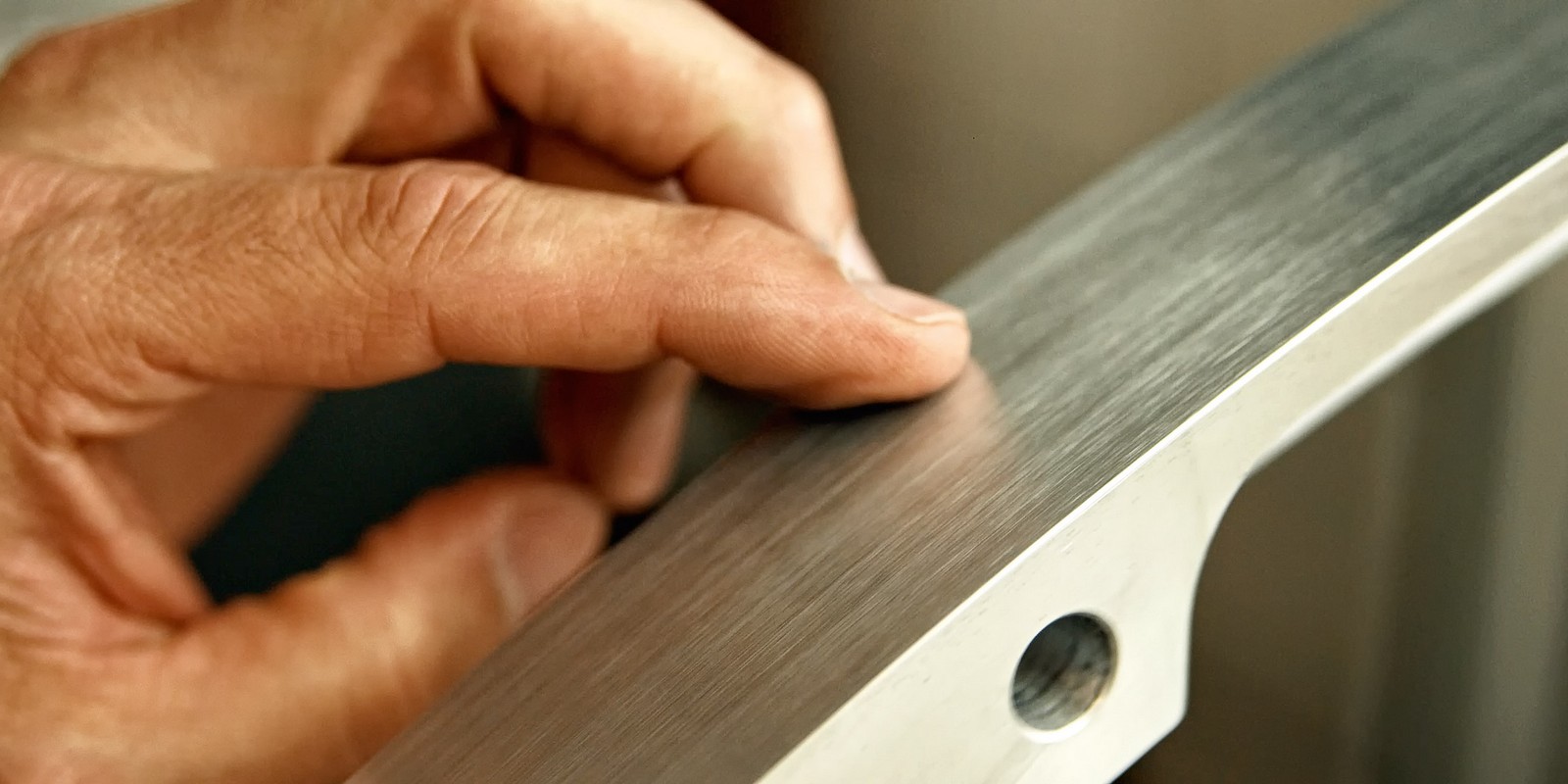
Enjoy unique dynamics, spatiality and impulse fidelity with any type of music. The Arcona series offers German high-end technology from our large series in the entry-level class. Like our top models, each Arcona features steep-sided and sophisticated crossovers, equipped with high-quality components, top-quality connection terminals and the best internal cabling. The main focus during development was to achieve an "unbeatable price/performance ratio". This has been impressively proven by numerous reviews and awards.
Arcona SD – the benchmark in this class
You can find an overview of all models here
The soft dome tweeter used in the Arcona series takes tweeter reproduction to a new level. This technical masterpiece has world-class weight and drive values.
Good loudspeaker diaphragms need to be light but sufficiently stiff to follow fast musical impulses. Our XPulse cone is made from lightweight aluminium with a super-light honeycomb plastic backing.
The drop-shaped enclosure prevents sound distortions caused by annoying reflection and diffraction effects. In addition, this shape increases stability and reduces sound colouration caused by cabinet resonance.
With the bass extension system, we offer you an easy way to extend the low-bass reproduction between 30 Hz and 60 Hz linearly downwards by an octave, which results in an enormous foundation for the size of the speakers. The roll-off can be perfectly adjusted to 6 different levels using the jumper or the separately available modules.
The Essen-based company WBT has been the world market leader in the field of speaker terminals for many years and sets the international standard with new gold plating methods. Speaker terminals have never sounded so good!
In our Arcona series, too, you can expect ultra-steep-flanked, balanced crossovers that perfectly define the drivers' operating range. The steep-flanked separation significantly increases power handling and impulse fidelity.

We use this technology for all our speakers. With the balanced crossover, the negative pole of the loudspeaker is not connected directly to the electric ground as is usually the case, but is decoupled from the ground of the system by crossover components (low-pass filter). This results in greatly reduced feedback to the amplifier. All our speakers can therefore be easily driven by different amplifier brands. The sonic advantages of this concept are expressed in a very finely resolved mid-range and higher speech intelligibility.
The picture clearly shows the structure of a symmetrical first-order filter. You need two coils, each of which has half the value of the other. We apply this principle to all our crossovers.

Passive speakers work in the analog world and have no power supply. The central element of a passive loudspeaker with multiple paths is the crossover. It assigns the frequencies to the individual paths. This is done using a more or less complex circuit consisting of inductors (inductance), capacitors (capacity) and resistors (ohmic resistance). An inductor blocks high frequencies, i.e. works as a low-pass filter, and a capacitor blocks low frequencies, i.e. works as a high-pass filter. A resistor reduces the sound pressure level of a single loudspeaker chassis, but works equally well at all frequencies.
If an analog, passive low-pass filter has a cut-off frequency of 200 Hz, this does not mean that it completely cuts off all higher frequencies above 200 Hz, but that it starts to suppress higher frequencies above 200 Hz more and more. For example, a 1st order low-pass filter cuts at 6 dB/octave. If you consider that 10 dB less still means half the volume, you realize that such a woofer still plays far into the mid to high frequency range.
Higher-order filters, which attenuate 6 dB/octave more steeply with each order, help to counteract this. A 3rd order low-pass filter attenuates at 18 dB/octave, but also requires 3 components.
What are the advantages of high-slope filters?
1. with flat filters, several drivers play simultaneously in each frequency range. Since the individual drivers are built completely differently, often have different cone materials and completely different sizes, this leads to:
a. Frequency response errors, i.e. incorrect tonal reproduction
b. Directivity effects, shifted dispersion characteristics
c. Phase errors, which manifest themselves in undefined spatial imaging
d. And impulse errors that make the music sound bland, undynamic and insignificant
e. Severe distortion at higher volumes, which sounds very unpleasant
f. In addition, the power handling capacity of the individual drivers is electrically and mechanically lower, as they have to radiate frequencies for which they are not designed for
2. since the individual drivers are exposed to much higher electrical and mechanical loads, they must be designed and constructed accordingly. However, since a midrange driver has to fulfill fundamentally different conditions than a woofer, only a compromise chassis that is neither a woofer nor a midrange driver can be used with flat filters. Perfect music reproduction is therefore more or less impossible, or at least severely limited.
All these disadvantages can be avoided by using high-slope filters. What are the disadvantages of high-slope filters? a. They require more components and are therefore considerably more expensive
b. Their calculation is much more complicated and requires sophisticated mathematical knowledge and calculation options
c. The group delay, i.e. the time it takes for a signal to pass through the filter, is somewhat longer. The designer must take this into account as far as possible, but the delays are generally at the audibility threshold, so they are not significant.
A sophisticated theory of the loudspeaker and of multi-way systems must therefore be worked out. This is exactly what we at Gauder Akustik have been doing for the last 30 years. Find out more here in our videos on our YouTube channel, in which Dr. Gauder explains the basic ideas and calculations of our loudspeaker mathematics:
https://www.youtube.com/watch?v=jz2sIYqfIVg&t=1s
https://www.youtube.com/watch?v=74x4JAAXAVQ
https://www.youtube.com/watch?v=2hFYsImgHS4&t=133s
sowie:
https://www.youtube.com/watch?v=y-JfgHVKzdk
https://www.youtube.com/watch?v=RAKnjraHIz8&t=2s
Our speakers all work with slopes of 50 dB/octave and more. This avoids all the disadvantages of flat filters described above and allows us to build truly specialist drivers. An immense advantage. And that's why our speakers sound so open, clear, spacious and have a wide listening zone, giving you a great, balanced sound image throughout the room.
Filter theory in electrical engineering shows that higher-order systems are more efficient than lower-order systems (edge steepness in electrical filters). Since a loudspeaker can also be described as an electrical filter, this also applies here. A closed box is a 2nd order filter (one moving mass with suspension), a bass reflex box is a 4th order filter (two moving masses, one the diaphragm, one the air in the bass reflex tube). This could give you the idea of building a 6th order filter with an additional mass-spring system purely electrically, because electrical resonant circuits have the same differential equation as mechanical mass-spring systems. This is exactly what we do with all our loudspeakers. The increased performance allows us to make the volumes smaller (smaller cabinet) and achieve a lower resonance frequency, so that the speakers go down lower than they are actually capable of.
This electrical high-pass filtering does not make the bass louder, but the cut-off frequency is decreased by almost an octave (more low bass!) and the cabinet becomes smaller. We call this amplification of the lowest octave (30 Hz - 60 Hz) bass extension and by inserting the jumper you can achieve an amplification of 4 dB at 40 Hz. If you plug one of our BE modules into these sockets, you can vary the amplification in 4 steps. You can find out more about this under Bass Extension.
Why do we build multi-way loudspeakers?
The human hearing ranges from 16 Hz to around 16,000 Hz (at a young age), i.e. over 10 octaves - an enormous range when you consider that the eye can only see one octave. Accordingly, it is difficult for a single loudspeaker to reproduce this wide range of frequencies.
In the bass range we need large, heavy cones with small magnets, in the mid-range we need light, much smaller cones with a strong drive and in the treble range we need very small, extremely light cones with the strongest possible drive. All of this follows from the laws of mechanics, strength of materials and, last but not least, acoustics.
As you can see, it is impossible to reconcile all these requirements. It is essential to make compromises here. A first compromise is to divide the 10 octaves between two loudspeaker drive-units. Such designs are correspondingly diverse, as the proportions of the individual chassis can vary greatly. In the classic three-way speaker, three specialists share the 10 octaves, which can bring a significant improvement. The same applies to four-way loudspeakers. Five-way loudspeakers are extremely rare and then hardly offer any more advantages.
The crossover
How do we build these multi-way loudspeaker systems?
A crossover is required so that the individual specialists are assigned their respective frequencies correctly. A crossover is a circuit consisting of inductors (inductivity), capacitors (capacitance) and ohmic resistors, which are connected together according to certain rules and then form so-called low-passes (only low frequencies are allowed through), high-passes (only high frequencies are allowed through) and band-passes (only medium frequencies are allowed through).
Unfortunately, these low, high and bandpass filters, also known as analog electrical filters, are not infinitely steep, so that lower and higher frequencies can still pass through, but are increasingly attenuated in the process. In the simplest filter circuits, they work with a slope of 6 dB/octave: every time the frequency is doubled or halved, the sound pressure level is reduced by 6 dB. 10 dB corresponds to a halving of the volume. However, studies have shown that sounds of -40 dB can still be perceived well. So if you remove a woofer at 400 Hz with a 1st order filter, this means that the bass speaker is 3 dB quieter at 400 Hz and then fades out at 6 dB/octave from 400 Hz. At 3200 Hz (3 octaves higher) it is only 18 dB quieter, which corresponds to about a quarter of the volume. It therefore still plays along well and overlaps with the signal from the midrange driver. At 400 Hz, both are equally loud.
The same happens at 3.200 Hz, where the tweeter generally takes over the music dispersion. At 3.200 Hz, the midrange and tweeter are equally loud and the midrange drops by 6 dB/octave. At 12.800 Hz, the midrange driver is therefore about 12 dB quieter, which corresponds to slightly more than half the volume. As the mid-range cones are heavier and larger than the tweeter cones, many mid-range drivers slowly stop emitting sound at 7.000 – 8.000 Hz by themselves. But one thing is clear: especially in the range from 3.400 Hz upwards, the wavelengths become smaller than 10 cm and if two loudspeaker drivers then emit the same signal, both signals interfere very strongly and thus distort the actual original signal. This cannot be good. You lose the spatial information and also the temporal impulse information. As a result of the fact that the individual musicians' entries are now blurred, the music loses its drive and crispness. And that's what music is all about!
What is the solution to this? Either you use a full- range driver (which is really very bad), you accept the misbehaviour (6 dB/octave crossovers) or you use crossovers that separate much more steeply, for example with 12 dB/octave or 18 dB/octave.
We at Gauder Akustik take this a big step further. We have developed a process in which the slope of our crossover filters is more than 50 dB/octave! After less than an octave, our individual drivers are no longer audible at all! The overlap is therefore very small, so that each drive-unit only emits the frequencies it is really capable of. Interference effects are minimized. The impulse response is optimal (as confirmed by the trade press in every test) and the spatial imaging remains stable and large. So using our loudspeakers you don't necessarily have to sit right in the middle! And of course the electrical load capacity is also higher, which dramatically increases the service life of the individual driver (this is one of the reasons why we give you a 10-year full guarantee when you register).
However, due to the complex circuitry, our crossovers have significantly more components than competitor products (e.g. 64 components in our DARC 200 three-way speaker), which makes them larger and much more expensive. We also have to use selected, high-quality, expensive components to ensure that the circuits function precisely. All this results in a not inconsiderable cost factor, but we accept this even for the Arcona 40 in order to set a sound milestone in every class.
What are the disadvantages of higher-order crossovers?
The group delay, i.e. the time it takes for an electrical signal to pass through the crossover, increases slightly. However, this effect is much smaller than musical instruments need to settle, but we also correct this disadvantage with our TDC technology.
As you can see, a sophisticated crossover is the most important component of a multi-way loudspeaker. That's why we spend so much time and effort on it!
Stellen Sie sich folgendes vor: ein Hochtöner in einer Lautsprecherbox muss Frequenzen von mindestens 20.000 Hz abstrahlen, das heißt, die Membran muss 20.000 mal pro Sekunde vorwärts und rückwärts schwingen. Das können nur Membranen aus einem ganz leichten Material, das aber dennoch sehr steif und hart sein muss, damit es sich nicht verbiegt. Der deutsche Spezialist Accuton stellt seit vielen Jahren einzigartige Keramikmembranen her, die genau diese offensichtlich gegensätzlichen Eigenschaften vereinen. Nach einer Entwicklungszeit von 2 Jahren ist es uns nun gelungen zusammen mit Accuton einen Keramikhochtöner zu entwickeln, der all diese Eigenschaften jetzt auch in die Arcona-Serie trägt.
Schon nach den ersten Sekunden des Hörens wird Ihnen klar, dass wir hier in dieser Preisklasse Neuland betreten. Noch nie gab es solch eine enorme Auflösung, einen solchen Detailreichtum. Der perfekte Einstieg ins absolute HighEnd!
Ein-Wege-Lautsprecher mit einem Breitbandchassis sind leider nur sehr begrenzt einsetzbar, da die physikalischen Bedingungen Bass und Höhen gleichzeitig abzustrahlen diametral entgegengesetzt sind. Deshalb gibt es Mehrwege-Lautsprecherboxen, die sich die vom Menschen hörbaren 10 Oktaven geschickt aufteilen: Große, schwere Bassmembranen mit kleinen Magneten, leichte Mitteltonmembranen mit extrastarken Magneten und kleine, extrem leichte aber harte Hochtonmembranen mit starken FeNd-Magneten.
Wichtig hier ist wie bei allen Ensembles deren Zusammenspiel. Dieses wird durch eine Frequenzweiche geregelt. Eine Frequenzweiche ist eine elektrische Schaltung, die aus den passiven Bauelementen Spulen (Induktivitäten, Kondensatoren (Kapazitäten) und ohm’schen Widerständen besteht. Mit ihrer Hilfe werden die entsprechenden Frequenzen zu ihren geeigneten Lautsprecherchassis geleitet. Die Sache hat nur einen Haken, diese Trennung ist leider sehr unvollkommen, so dass Frequenzbereiche oftmals von zwei Lautsprecherchassis gleichzeitig abgestrahlt werden. Und das ist das große Problem, weil dadurch viele Impulse in der Musik verschliffen werden und die Dynamik verschlechtert wird, was die Musikwiedergabe fad und langweilig macht.
Abhilfe schaffen „steilere“ Filter, die die Trennungsstärke (Stichwort: Flankensteilheit) erhöhen. Allerdings sind solche Filter aufwendig und teuer und äußerst schwierig zu berechnen. Aber: Hierzu gibt es keine Alternative!
Deshalb verwenden wir in allen unseren Lautsprecherboxen ausschließlich steilflankige, phasenlineare Filter mit korrigierten Gruppenlaufzeiten mit Flankensteilheiten von 50 bis 60 dB/Oktave, was einem Vielfachen der herkömmlichen Filter entspricht.
Unsere Lautsprecher klingen deshalb im Gegensatz zu vielen anderen sehr lebendig, räumlich und äußerst natürlich. Sie hören das bereits nach einigen Sekunden. Vergleichen Sie deshalb unsere Lautsprecher mit Ihren bekannten Musikstücken und lassen Sie sich von dieser feinen, lebendigen Musikwiedergabe überzeugen.
Die XPuls-Membran, die von GAUDER AKUSTIK eigens für die Arcona-Serie entwickelt wurde, besteht aus Aluminium mit einer rückseitigen Polymerbeschichtung. Durch gezielte Füllungen von Polymeren gewinnt die XPuls-Membran im Fertigungsprozess an Härte und Gewicht. So ist es möglich, dass die XPuls-Membran die positiven Eigenschaft von weichem und hartem Membranmaterialien vereint. Das Ergebnis ist ein sehr linearer Frequenzgang und ein perfektes Impulsverhalten.
Die bei hohen Frequenzen (> 6 kHz) auftretenden Resonanzen werden durch unsere Technologie der ultrasteilflankigen Frequenzweichen so effektiv unterdrückt, dass sie weder zu messen noch zu hören sind.
Diesen technisch klingenden Eigenschaften haben nur einen Sinn: Ihnen die Musik zu erschließen, sie Ihnen näher zu bringen, dabei aber die charakteristischen Klangfarben der einzelnen Instrumente beizubehahlten und die räumlichen Gegebenheiten bei der Aufnahme authentisch wiederzugeben. Wie perfekt uns das gelungen ist, können Sie beim Fachhändler jederzeit in einem Hörvergleich nachvollziehen.
In der Filtertheorie der Elektrotechnik werden Schaltungen, die den Frequenzgang beeinflussen auch als elektrische Filter bezeichnet. Beim Lautsprecher sind die elektrischen Filter Teilfilter eines gesamten akustischen Übertragungssystems. Zu den elektrischen kommen hier noch die mechanischen und die akustisch wirkenden Filter hinzu. In seiner Gesamtheit ergibt sich ein akustisches Filter, das die Eigenschaften eines Lautsprechers in seiner Gesamtheit beschreibt, das also, was wir als Frequenzgang, Phasengang und Zeitverhalten (Impulsverhalten) bezeichnen.
Filter haben verschiedene Sperrwirkung und Wirkungsgrad, je nachdem, wie aufwendig sie konstruiert sind. Das einfachste Lautsprecherfilter ist die geschlossene Box mit einer Sperrwirkung von 12 dB/Oktave. Man spricht hier von einem Filter 2. Ordnung, da jede Ordnung eine Flankensteilheit der Sperrwirkung von 6 dB/Oktave verursacht. Da eine Bassreflexbox zwei schwingende Masse-Feder-Systeme besitzt (Lautsprechermembran und schwingende Luftsäule im Rohr), ist das Bassreflexsystem ein Filtersystem 4. Ordnung mit einer Sperrwirkung nach unten von 24 dB/Oktave und einem erhöhten Wirkungsgrad im Bassbereich. Es ist deshalb sehr beliebt und effektiv. Dadurch dass eine Bassreflexbox eine Gehäuseöffnung hat, können von der Membran Gehäuse-Luftresonanzen angeregt werden, die durch das Rohr nach außen abgestrahlt werden und speziell im Mitteltonbereich starke Klangverfärbungen hervorrufen. Bei Zweiwegsystemen kann das ein ernstes Problem sein. Für ein Zwei-Wege-System empfiehlt es sich also, die Filterordnung durch elektrische Filter zu erhöhen. So kann ein elektrisches Hochpassfilter 1. Ordnung bei richtiger Dimensionierung eine Erweiterung des Bassbereichs um mehr als eine halbe Oktave nach unten bewirken, was einer kleinen Regalbox durchaus ein kräftiges Fundament geben wird. Ein elektrisches Filter 2. Ordnung bewirkt sogar eine Basserweiterung um fast eine ganze Oktave, wodurch ein Subwoofer überflüssig wird.
Darüber hinaus erhöhen solche elektrischen Hochpassfilter die Impedanz ganz unten im Tiefstbassbereich (1 Hz -20 Hz) und ersparen dem Chassis dadurch extreme Auslenkungen, falls die Aufnahme mit subsonischen Anteilen oder extremen Tiefbässen überladen ist. Denn dafür ist eine Regalbox ja absolut nicht ausgelegt. Solche elektrischen Filter haben also in Verbindung mit Basslautsprechern durchaus erstaunliche Auswirkungen, weshalb wir darauf nicht verzichten wollen. Eines ist aber natürlich klar: auch hier gilt der Energieerhaltungssatz der Physik. Die Tiefbass-Erweiterung wird durch eine Reduktion der Impedanz im Bereich 25 Hz – 35 Hz erkauft, wodurch die Lautsprecherbox mehr Strom (Energie) aus dem Verstärker zieht, um den Bassbereich aufzufüllen. Für größere Röhrenverstärker, Transistorverstärker oder Schaltverstärker stellt das i.A. kein Problem dar, es sei denn Sie wollen extrem laut hören. Kleineren Röhrenverstärker hingegen geht da schon mal die Luft aus. Durch Ziehen der Bass-Extension-Brücke können Sie dann die Hochpassfilterung deaktivieren. Dadurch erhöht sich die Impedanz und die angeforderte Energie wird deutlich geringer. Und so können Sie unsere Lautsprecherboxen dann auch mit einem kleineren Röhrenverstärker betreiben.
Hinter der schlanken Formgebung der ARCONA verbirgt sich ein aufwändig gearbeitetes 22 mm starkes MDF-Gehäuse im Soft-Design. Die nach hinten geschwungene Tropfenform und abgerundete Ecken vermeiden klangverfälschende Reflexions- und Beugungseffekte. Gezielt platzierte Versteifungsrippen im Lautsprechergehäuse sorgen für die nötige Steifigkeit und eliminieren Eigenresonanzen nahezu vollständig.
Die Gehäusegeometrie sowie die nach unten abstrahlende, strömungsoptimierte Bassreflexöffnung sichern eine gleichmäßige Raumanregung und schaffen eine einzigartige Bühnenpräsenz.
Selbstverständlich können Sie einen Bespannrahmen zu jeder Arcona-Lautsprecherbox käuflich erwerben.
Lieferbare Oberflächen: Klavierlack schwarz, Klavierlack weiß
Im ausführlichen Lautsprecherhandbuch finden Sie nicht nur Themen zu den verschiedenen Anschlussmöglichkeiten sondern auch ausführliche Tipps und Ratschläge zur Raumakustik, Lautsprecheraufstellung und Klangverbesserungsmöglichkeiten Ihres Hörraum/HiFi-Systems.

01/20
Arcona 60 MKII

04/20
Arcona 100

01/21
Arcona 100 MKII

08/21
Arcona 40 MKII

10/21
Arcona 80 MKII

01/22
Arcona 80 MKII

09/22
Arcona 60 MKII SD

11/22
Arcona 80 MKII SD

Readers' choice 2021
Arcona 60
1st place

Readers' choice 2022
Arcona 40
1st place

Readers' choice 2022
Arcona 40
1st place

Readers' choice 2022
Arcona 80
1st place

Readers' choice 2022
Arcona 100
2nd place

Readers' choice 2023
Arcona 60
1st place

Readers' choice 2023
Arcona 80
1st place


Von der Entwicklung über die Fertigung bis zur finalen Endkontrolle mit Hörtest – jeder Lautsprecher wird in Renningen gefertigt.

Mit unserem einzigartigen Lifetime-Update bleibt Ihr Lautsprecher immer auf dem technisch und klanglich neuestem Stand.

Der neue seidenweich zeichnende Hochtöner bringt die Hochtonwiedergabe aller Arconas auf ein neues Niveau.

Wir wissen um die Qualität unserer Lautsprecher. Deshalb gewähren wir für registrierte Lautsprecher
10 Jahre Garantie.

The amplifier is an important component in each HiFi system. We recommend the TAE 150 integrated amplifier and the PAE 150 power amplifier from Electric Audio for all our loudspeakers. The absolute non-plus-ultra in terms of sound and performance!
More about the amplifier
We use our own Clearwater cables as internal wiring in our loudspeakers. We therefore recommend using one of our Clearwater cables as a speaker cable, too. Ask your Gauder Akustik dealer about this or give us a call! We will be happy to advise you.
Would you like more information about our speakers? Would you like to visit our factory or test a loudspeaker?
Please feel free to call us (phone +49 7159 920161) or send us this contact form. We will get back to you as soon as possible.
YOUR GAUDER AKUSTIK TEAM
This site was created with the Nicepage


